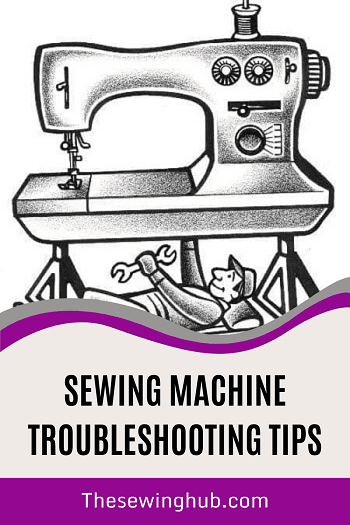 When you are using a machine, there will be trouble after a few uses. That doesn’t mean the sewing machine requires servicing.
When you are using a machine, there will be trouble after a few uses. That doesn’t mean the sewing machine requires servicing.
It could very well mean you haven’t set or cleaned the sewing machine right.
Such common issues have easy troubleshooting that doesn’t need professionals to solve if you know how to do it.
So, we are sharing some troubleshooting tips right below.
Tips #1 – Inconsistent Bobbin Tension
You haven’t placed the bobbin in its slot the right way. Those who are skilled in sewing take no time installing the bobbin and threading the sewing machine. However, we were all once a beginner, and we know how crucial this technique of installing the bobbin can be.
Putting the bobbin and taking out the bottom thread is tricky after taking the upper thread through the guides, tension discs, and regulator, then the bobbin-case spring, finally to the needle and bringing the upper and bottom thread together sets the tension right.
Take your time and do that carefully. Also, always keep the bobbin slot clean and lint-free for sewing with a consistent bobbin tension.
Tips #2- Inconsistent Fabric Feed
A worn-out presser foot or a not so correctly set presser foot causes the inconsistent fabric feed causing the jamming and puckering of the fabric below it. Every presser foot you use to sew has a purpose. So you must use each one of them accordingly following that purpose.
Heavy materials require specific placement of the presser feet, and thin, delicate fabrics need the setup to be opposite. However, in all cases, the presser feet must not be too low, and you must sew with a moderate stitch length, not zero.
It should remain on a certain height pressing the cloth evenly, not tightly hindering the even feed of the fabric. In most sewing machines, pressure feet remain 2mm above the needle plate.
Tips #3 – Needle Bends, Even Breaks
You are using a low-quality needle or wrong-sized needle, which doesn’t even suit the fabric. Also, never use a needle for too long on several projects of yours. It’s better to use high-quality needles and change them after every one or two projects, even if they seem absolutely usable.
A wrongly inserted needle in the needle bar also causes needle breaks and bends. Keeping your fabric even, not taut or puckered, is essential even for the needle not bending and breaking. If you hold it too tight or mistakenly sew on the pins you inserted on the fabric for better hold, needle breaking and bending are inevitable.
Tips #4 – Breaking Of The Thread
Every component you are using to sew your projects is connected and requires proper matching. If not, then the thread will break in between the sewing, hindering a constant sewing flow. The thread size must match the needle size and vice versa.
You cannot use a thick thread in a small needle. Any imbalance between the components and accessories will end you up with thread breaking and shredding. Also, use high-quality thread always.
Tips #5 – Thread Nesting Up
You have set the thread tension too tight and might have missed a guide or two while you threaded your machine, causing an inconsistent bobbin tension. Taking the thread from the wrong side to thread the sewing machine also hinders the normal flow of the thread.
So, your thread will start bunching, ruining the project you are working on. Keep your presser feet at the right height hugging the fabric, not too tight or loose. It must glide on the material smoothly; otherwise might cause the bunching of the thread.
Though weird to think of, an unclean machine can also cause thread bunching along with the upper thread and lower thread not taken out and combined to the back of the presser foot.
Tips #6- Uneven Stitches
If you are getting uneven stitches on your fabric, then check the thread quality. It might be of cheap quality hence produce more lint than it should, interrupting the even stitches. The thread not being correctly threaded on the machine and the incorrect thread tension also causes uneven stitches.
You should follow all the thread guides in the proper order, from the right sides, and set the tension not too stretched or loose to get the even stitches. Even the presser feed must press the fabric with the proper pressure to get the even stitches on the material.
Tips #7 – Noisy Machine
Your machine is long due for a thorough cleaning, inside out. If you are a complete professional and use your sewing machine for long hours daily, you need to clean the machine daily or within a day or two. The same applies to the oiling. Your sewing machine requires proper oiling.
If it’s not getting enough oil, it will start making weird noises. Low-quality oil or oil from a random brand not made to use for a particular machine can also cause damage due to lack of oiling and maintenance causing noises.
There could be tons of other issues, very simple or too complex. However, above were the most typical troubles that a sewist faces while sewing and their troubleshooting.